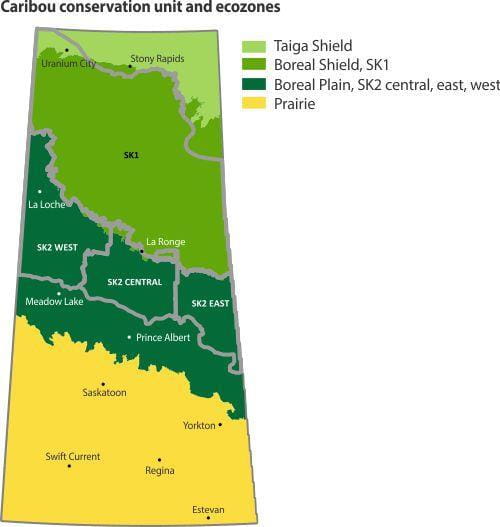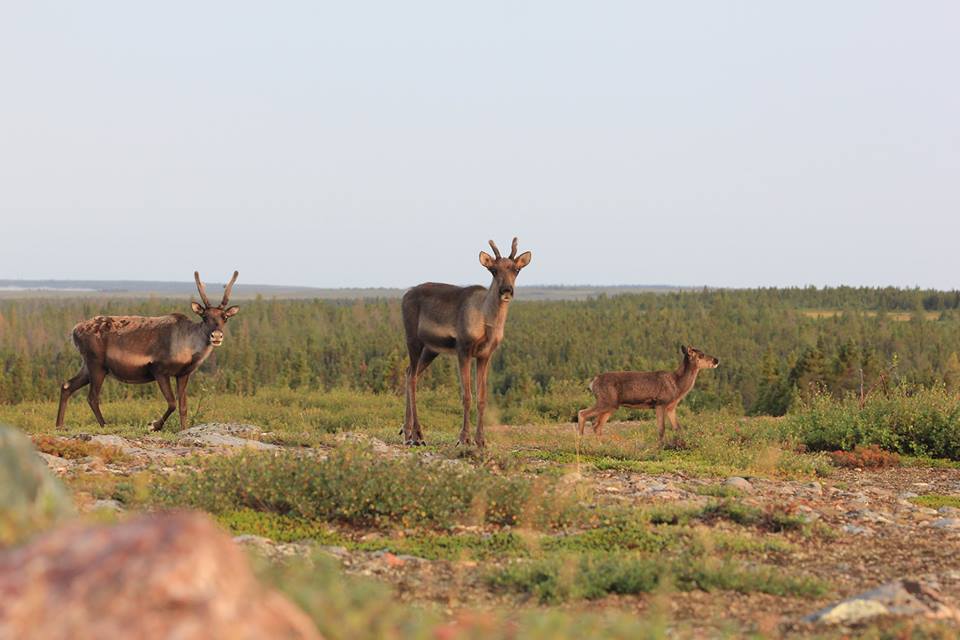Woodland and Barren ground Caribou: What’s the Difference?

By Caitlyn Anhorn
Woodland and Barren ground caribou are both native to Saskatchewan, but do they live in the same areas? Are they long lost cousins? Do they look the same? Keep on reading to find out more!
Some background information
To start, a species is a group of similar organisms that can interbreed freely and a subspecies is a subgroup of species that have different traits.
Woodland (Rangifer tarandus caribou) and Barren ground (Rangifer tarandus groenlandicus) Caribou are both subspecies of the caribou (Rangifer tarandus) species.

The Woodland Caribou in Saskatchewan are part of the boreal population which spans from Northwest Territories and British Columbia to Newfoundland. The Barren ground Caribou in Saskatchewan are part of the Bathurst, Qamanarijuaq, Ahiak, and Beverly populations which travel between Manitoba, Saskatchewan, Alberta, Northwest Territories, and Nunavut.



Most Woodland Caribou live in the more southern part of the boreal forest, in the boreal plain and boreal shield. Barren ground Caribou live in the very northern region of Saskatchewan, in the taiga shield. However, there is also a small section where the Woodland and Barren ground Caribou range overlap in the northern part of the boreal shield.



Similarities between Woodland and Barren ground Caribou
Since both Woodland and Barren ground Caribou are the same species, they have quite a few similarities. They both live for an average of 4.5 years and up to 15 years.
Caribou all have special crescent-shaped hooves that help them navigate through the snow, water, and soft grounds. In the winter, their hooves get hard on the outside and soft on the inside, and they grow hair that protects them from the cold. In the summer, the hard part of their hooves gets worn from walking on hard surfaces and the padding (that was covered in hair during the winter) grows to help them walk in swampy areas. If caribou sense danger, they rise on their back hooves, which release a scent to warn the others. How neat!
Both female and male caribou grow antlers during the year, then lose them. Males lose their antlers after mating in the fall and females lose theirs in the spring, usually after they give birth.
Though both subspecies are similar in many ways, they each have specific characteristics that make them different.
Woodland Caribou
Woodland Caribou have the largest body size of all caribou subspecies, being 1.0 to 1.2 meters tall and weighing 110 to 210 kilograms. Specifically, their heads and legs are longer than those of Barren ground Caribou.
They are dark brown in the summer and grey in the winter, with white patches on their neck, mane, shoulders, underbelly, under their tail, and above their hooves. In the winter, their antlers are thicker and broader than those of Barren ground, and are flattened, compact, and relatively dense.
Boreal Woodland Caribou prefer to live in undisturbed and mature to old-growth forests, where their major food source, lichen, is abundant. In the summer, they also eat grass, moss, willow leaves, and other plants. They are a non-migratory subspecies that live in small groups of generally 15 or fewer individuals within the boreal. If there are disturbances in the area, the caribou relocate to another spot within their range. This is why connectivity between habitats is crucial for Woodland Caribou.
For calving, pregnant boreal Woodland Caribou cows travel to an isolated area where food is abundant, and predators are few and far between. Generally, female and male caribou live in a group of boreal caribou; however, females live separately during calving.
The boreal population of Woodland Caribou have been listed as threatened on the Canadian Species at Risk Act since 2003.



Barren ground Caribou
Barren ground Caribou are 1.1 meters tall and weigh between 100 and 140 kilograms. They have the largest antlers relative to body size when compared with other caribou subspecies.
They are light brown in the summer and sandy beige in the winter, with a dark face and white muzzle, and white patches along the neck, underbelly, beneath the tail, and above the hooves.
By nature, Barren ground are migratory creatures, travelling due to food supply, snow, and calving. Migration goes like this:
- In the spring, the female caribou (cows) and calves from the previous year (yearlings) travel north to the approximate calving grounds. Pregnant cows gather and have their young simultaneously within a few weeks of each other. The calving time and location is coordinated with the “green-up” when tundra flora becomes available. Calves are born sometime in June. Non-pregnant cows and young males (bulls) move north, followed by the adult bulls.
- In the summer, cows, calves, and bulls live together in the tundra. Near the end of summer and beginning of fall, everyone begins moving south towards the tree line, while also feeding to prepare for mating season.
- The fall is mating season – the rut.
- In the winter, mature bulls live separately than the cows and their calves within the forest. Barren ground Caribou move around depending on food availability.
There are many threats to Barren ground Caribou, including but not limited to habitat loss and disturbances, contaminants, climate change, disease, and predation. Barren ground Caribou are being considered for addition to the Species at Risk Act as threatened across Canada, but no decision has been made yet.
Barren ground Caribou are essential to the Denesųłiné from Nuhenéné, the Athabasca region. To learn more about Nuhenéné, visit www.denesuline.com.



Tying it all together
To conclude, both Woodland and Barren ground Caribou are incredibly important to Saskatchewan and its people. Both subspecies play integral roles to Indigenous peoples and culture.
As Saskatchewan residents, we can all play a role in conserving and protecting the caribou species. Learning more about them and their differences is just one important step. Thank you for taking this step today!
Read more
(1) Woodland Caribou (Rangifer tarandus), Boreal population
(2) Recovery Strategy for the Woodland Caribou (Rangifer tarandus caribou), Boreal population, in Canada
(3) Caribou in Canada: Caribou subspecies – Caribou commonalities
(4) Hinterland Who’s Who – Caribou
(5) Environment and Natural Resources – Barren ground caribou.
